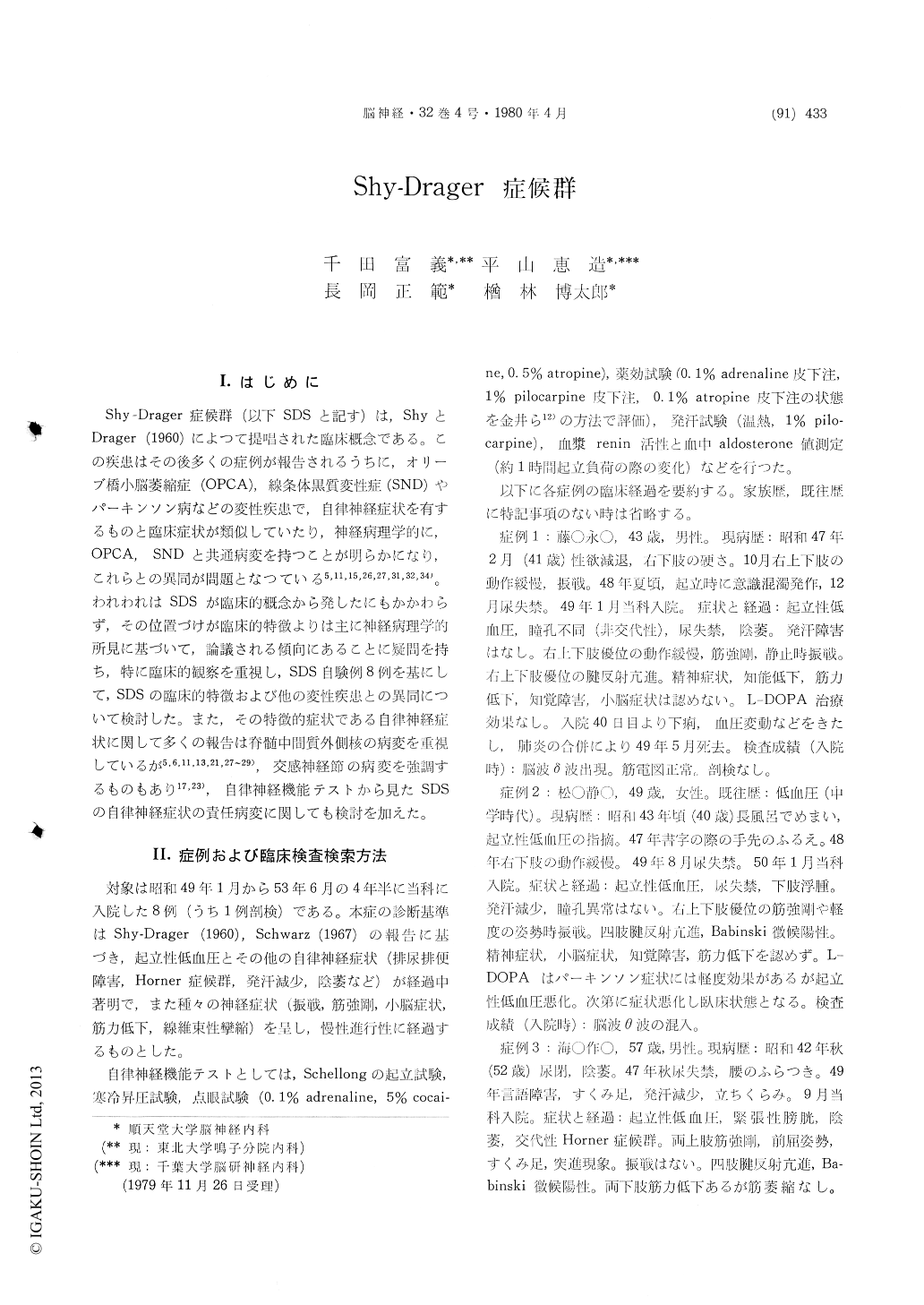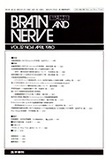Japanese
English
- 有料閲覧
- Abstract 文献概要
- 1ページ目 Look Inside
I.はじめに
Shy-Drager症候群(以下SDSと記す)は,ShyとDrager (1960)によつて提唱された臨床概念である。この疾患はその後多くの症例が報告されるうちに,オリーブ橋小脳萎縮症(OPCA),線条体黒質変性症(SND)やパーキンソン病などの変性疾患で,自律神経症状を有するものと臨床症状が類似していたり,神経病理学的に,OPCA,SNDと共通病変を持つことが明らかになり,これらとの異同が問題となつている5,11,15,26,27,31,32,34)。われわれはSDSが臨床的概念から発したにもかかわらず,その位置づけが臨床的特徴よりは主に神経病理学的所見に基づいて,論議される傾向にあることに疑問を持ち,特に歯臨床的観察を重視し,SDS自験例8例を基にして,SDSの臨床的特徴および他の変性疾患との異同について検討した。また,その特徴的症状である自律神経症状に関して多くの報告は脊髄中間質外側核の病変を重視しているが5,6,11,13,21,27,29),交感神経節の病変を強調するものもあり17,23),自律神経機能テストから見たSDSの自律神経症状の責任病変に関しても検討を加えた。
Since the original description of Shy-Drager syndrome (SDS) by Shy and Drager in 1960, many cases have been reported. However, it is still open to question whether Shy-Drager syndrome is disease entity or not, since its pathological findings are similar to those of olivo-pontocerebellar atrophy (OPCA) and striato-nigral degeneration (SND) which of ten have autonomic disturbances in their courses. Some investigators proposed to use the term multiple system atrophy to cover the whole group including SDS, OPCA and SND, mostly based on pathological findings. The authors tried to clarify this problem in view of clinical mani-festations.
In the present study, 8 cases of Shy-Drager syndrome with one autopsied case were analyzed as to the disturbances of the autonomic nervous system and neurological symptoms to examine the lesions attributable to autonomic disturbances and to compare the clinical features of SDS with those of OPCA and SND. The autonomic disturbances were examined by means of Shellong test, cold pressure test, sweat test, instillation test, sub-cutaneous injection of adrenaline, pilocarpine andatropine, and change of plasma renin activity and blood aldosterone by standing. The results were as follows:
1) The disturbances of autonomic nervous system of SDS were severer and more variable than those of OPCA and SND, and the postganglionic fibers of sympathetic nerves as well as the intermedio-lateral nuclei seemed to be degenerated.
2) Sometimes, plasma renin activity and blood aldosterone were not elevated after standing for more than 1 hour. According to the results of the sweat test by subcutaneous injection of pilo-carpine and the pharmacological test by sub-cutaneous injection of adrenaline, damage to the postganglionic fibers of sympathetic nerves was suggested in these cases.
3) Eight cases of SDS showed two characteristic clinical courses. In the first group autonomic dis-turbances were the initial symptoms, followed by parkinsonian symptoms within 5 years. In the second autonomic disturbances were the initial symptom as the first, however, followed by cere-bellar symptoms within 3 years and parkinsonism symptoms much later. These patterns of clinical course seem to be important, since such initial appearance of autonomic disturbances is not usualy observed in OPCA and SND.
Although the pathological findings of SDS are sometimes similar to those of OPCA and SND, its spectrum of autonomic symptoms and clinical course differ from those of OPCA and SND. SDS should be considered as a separate clinical entity, and may not belong to the same groups of diseases as OPCA and SND.

Copyright © 1980, Igaku-Shoin Ltd. All rights reserved.


